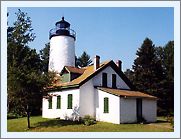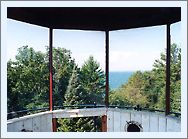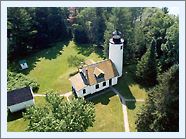|
Historical Information

The story of the first Light station on Michigan Island in 1857
is one of the Apostles great mysteries. While there are many details
surrounding the origin of the station yet to be discovered, all
indications are that the establishment of this beautiful old structure
was rooted in ether bureaucratic bungling or outright deceit.
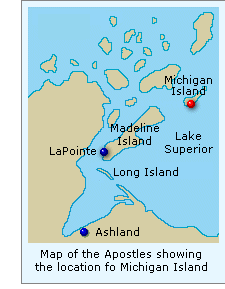 Commerce on Lake Superior at the middle of the
nineteenth century was very different than it is today, and
while the discovery of iron ore in the Missabe Range would soon cause
the twin ports of Duluth & Superior to assume the role of Superior's preeminent
ports, in 1850 the
bustling fur trading center at La Pointe on Madeline Island served as
the lake's hub of maritime commerce. Although the harbor at LaPointe was
protected from deadly Superior Nor'westers by its situation in the lee of
the Apostle Islands, and from Northeasterly blows by the body if
Madeline Island itself, entry into the harbor was no simple task from
any direction. Commerce on Lake Superior at the middle of the
nineteenth century was very different than it is today, and
while the discovery of iron ore in the Missabe Range would soon cause
the twin ports of Duluth & Superior to assume the role of Superior's preeminent
ports, in 1850 the
bustling fur trading center at La Pointe on Madeline Island served as
the lake's hub of maritime commerce. Although the harbor at LaPointe was
protected from deadly Superior Nor'westers by its situation in the lee of
the Apostle Islands, and from Northeasterly blows by the body if
Madeline Island itself, entry into the harbor was no simple task from
any direction.
Captains making for La Pointe from the
east were forced to thread the needle through the narrow South Channel
between Long Island and the southerly tip of Madeline Island, before
swinging northwest into more open water, and thence to the harbor at
LaPointe. Vessels wishing to avoid the South Channel by swinging around
the northerly end of Madeline Island were forced instead to negotiate
between the Madeline coast and Michigan, Stockton, and Basswood Islands
before swinging south to LaPointe. Given the choice, almost all captains
chose the route through the South Channel, since it was a considerably
shorter distance. Shorter distances meant less time, and even in the mid
nineteenth century commercial captains were only too aware of the fact
that time was money. While making the passage through the South Channel
under sail was difficult under the best of conditions, without the
benefit of a light to mark the westerly tip of Long Island, the task was
formidable under darkness or in thick weather of any kind.
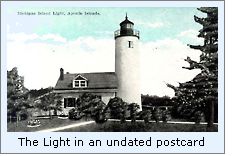 Taking up the cause of maritime
interests on February 8, 1851, Wisconsin Senator Orasmus Cole presented
a memorial before Congress on behalf of the Wisconsin Legislature
praying "for an appropriation to build a light-house at La Pointe,
on the southern shore of Lake Superior." On March 3, 1853, Congress
appropriated $5,000 for the construction of the LaPointe light, and in
his annual report for that same year, Eleventh District Inspector
Captain Lorenzo Sitgreaves reported that plans for the station had been
drawn up, a site had been selected, steps were underway to obtain title
for the reservation, and directions would be given for getting the work
underway. Uncharacteristically, no mention was made of the exact
location chosen for the new station. Taking up the cause of maritime
interests on February 8, 1851, Wisconsin Senator Orasmus Cole presented
a memorial before Congress on behalf of the Wisconsin Legislature
praying "for an appropriation to build a light-house at La Pointe,
on the southern shore of Lake Superior." On March 3, 1853, Congress
appropriated $5,000 for the construction of the LaPointe light, and in
his annual report for that same year, Eleventh District Inspector
Captain Lorenzo Sitgreaves reported that plans for the station had been
drawn up, a site had been selected, steps were underway to obtain title
for the reservation, and directions would be given for getting the work
underway. Uncharacteristically, no mention was made of the exact
location chosen for the new station.
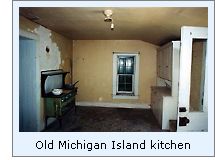 Milwaukee builders Sweet, Ranson, and
Shinn were awarded the contract for building the LaPointe Light and a
number of other stations on Superior in 1854. However, there was
evidently some contention with the contract that required settlement
before work could begin, since Sitgreaves reported that "Owing to
the late day at which the sanction of the board to the contract was
obtained, the light-houses on Lake Superior have not yet been
commenced." The annual report for the following year indicated only
that work on the Light had begun, and the 1856 report stated merely that
the work was "in progress." The station was completed late in
1856, and consisted of a small whitewashed stone 1½ story keepers
dwelling with an attached stone tower standing 64-feet tall, and capped
with an octagonal cast-iron lantern. On completion, the contractors were
required to submit the structure to the district inspector for his
approval, and in the 1857 annual report it was stated that acceptance of
the station was refused, due to the fact that it was "not built in
conformity to the terms of the contract." Milwaukee builders Sweet, Ranson, and
Shinn were awarded the contract for building the LaPointe Light and a
number of other stations on Superior in 1854. However, there was
evidently some contention with the contract that required settlement
before work could begin, since Sitgreaves reported that "Owing to
the late day at which the sanction of the board to the contract was
obtained, the light-houses on Lake Superior have not yet been
commenced." The annual report for the following year indicated only
that work on the Light had begun, and the 1856 report stated merely that
the work was "in progress." The station was completed late in
1856, and consisted of a small whitewashed stone 1½ story keepers
dwelling with an attached stone tower standing 64-feet tall, and capped
with an octagonal cast-iron lantern. On completion, the contractors were
required to submit the structure to the district inspector for his
approval, and in the 1857 annual report it was stated that acceptance of
the station was refused, due to the fact that it was "not built in
conformity to the terms of the contract."
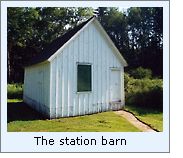 While the specific grounds for its
rejection were never clarified, ten years later in the 1867 Lighthouse
Board annual report, an "out of the blue" reference speaks of
the desire to re-establish a light station on Michigan Island which was
"discontinued in 1857." Since no mention of a lighthouse on
Michigan Island is made in any annual reports or Light Lists prior to
1857, and Light Lists after 1867 state that the station was built in
1857, it appears likely that Sweet, Ranson and Shinn built the LaPointe
Light station on Michigan Island, and the station was never placed into
service, or only placed in service for one season. This is also born out
by the fact that the contractors subsequently submitted a number of
invoices to the District Inspector and President of the Lighthouse Board
for additional expenses incurred in erecting the station on Michigan
Island, as opposed to the flatter land at Long Island, where they were
originally instructed to build. While it is possible that the
contractors built the station on Michigan Island in error, it is
difficult to believe that they would have subsequently attempted to
obtain additional payment for their increased expenses with such fervor
had they not built it exactly where they were instructed. Thus, it would
appear that they were either erroneously instructed to build on Michigan
Island, or someone in the Lighthouse Establishment was attempting to get
two stations built for the price of one. While the specific grounds for its
rejection were never clarified, ten years later in the 1867 Lighthouse
Board annual report, an "out of the blue" reference speaks of
the desire to re-establish a light station on Michigan Island which was
"discontinued in 1857." Since no mention of a lighthouse on
Michigan Island is made in any annual reports or Light Lists prior to
1857, and Light Lists after 1867 state that the station was built in
1857, it appears likely that Sweet, Ranson and Shinn built the LaPointe
Light station on Michigan Island, and the station was never placed into
service, or only placed in service for one season. This is also born out
by the fact that the contractors subsequently submitted a number of
invoices to the District Inspector and President of the Lighthouse Board
for additional expenses incurred in erecting the station on Michigan
Island, as opposed to the flatter land at Long Island, where they were
originally instructed to build. While it is possible that the
contractors built the station on Michigan Island in error, it is
difficult to believe that they would have subsequently attempted to
obtain additional payment for their increased expenses with such fervor
had they not built it exactly where they were instructed. Thus, it would
appear that they were either erroneously instructed to build on Michigan
Island, or someone in the Lighthouse Establishment was attempting to get
two stations built for the price of one.
 While the specific reasons behind the
construction of the Light on Michigan Island remain to be discovered,
Lighthouse Board annual reports and Light Lists both indicate that the
LaPointe light, consisting of a small wooden keepers dwelling with
integrated roof-mounted tower was finally built on the southwestern tip
of Long Island in 1858, and the Michigan Island light remained unmanned
and abandoned for ten years. While the specific reasons behind the
construction of the Light on Michigan Island remain to be discovered,
Lighthouse Board annual reports and Light Lists both indicate that the
LaPointe light, consisting of a small wooden keepers dwelling with
integrated roof-mounted tower was finally built on the southwestern tip
of Long Island in 1858, and the Michigan Island light remained unmanned
and abandoned for ten years.
 By the mid 1860's vessel traffic in and
out of LaPointe waned, with the major east-west shipping lanes moving
just to the north off the Apostles. Determining that a light at the
northeastern end of the islands would serve as a valuable guide to
westbound mariners, in 1867 the Lighthouse Board determined that
reactivating the old Michigan Island Light would serve as an inexpensive
solution. Since the old station had been sitting inactive and unmanned
for ten years, it had suffered considerable deterioration as a result of
its exposure to the elements and lack of maintenance. Thus the Board
recommended that an appropriation of $6,000 be made to refurbish the
buildings, install a new lens and reactivate the light. Congress
appropriated the requested funds on July 20, 1868, and the Board
dispatched a crew to the island to begin refurbishing the station the
following year. Roswell H Pendergast was appointed as the station's
first keeper, and he arrived to assume his responsibilities on June 10.
The district lampist lantern was dispatched to the island to install a
Third-and-a-half Order Fresnel lens, which Pendergast exhibited for the
first time on the night of September 15, 1869. By the mid 1860's vessel traffic in and
out of LaPointe waned, with the major east-west shipping lanes moving
just to the north off the Apostles. Determining that a light at the
northeastern end of the islands would serve as a valuable guide to
westbound mariners, in 1867 the Lighthouse Board determined that
reactivating the old Michigan Island Light would serve as an inexpensive
solution. Since the old station had been sitting inactive and unmanned
for ten years, it had suffered considerable deterioration as a result of
its exposure to the elements and lack of maintenance. Thus the Board
recommended that an appropriation of $6,000 be made to refurbish the
buildings, install a new lens and reactivate the light. Congress
appropriated the requested funds on July 20, 1868, and the Board
dispatched a crew to the island to begin refurbishing the station the
following year. Roswell H Pendergast was appointed as the station's
first keeper, and he arrived to assume his responsibilities on June 10.
The district lampist lantern was dispatched to the island to install a
Third-and-a-half Order Fresnel lens, which Pendergast exhibited for the
first time on the night of September 15, 1869.
 Day to day live at the station remained
fairly uneventful for the next thirty years. As a result of receding
water levels, the boat house was moved 45 feet nearer to the water in
1884, and leaks in the lantern roof were causing enough of a problem
that a tin hood was installed over the lantern to protect it from water
dripping from holes in the roof. Fortunately keeper John Pasque managed
to escape injury in 1889 when the lantern was struck by lightning, and
the lightning bolt carried down the spiral cast iron stairs before
scattering across the concrete floor at the base of the tower. The
446-foot wooden walk and stairway leading from the boat landing at the
bottom of the cliff to the station above, was rebuilt, and a brick oil
storage building was built 75-feet from the dwelling the following year.
Evidently, winter ice was causing havoc to the landing cribs since the
lighthouse tender Amaranth brought a work crew to the island in 1897 to
completely rebuild them, and the returned five years later in 1902 to
rebuild them yet again, along with building a new barn for storage. Day to day live at the station remained
fairly uneventful for the next thirty years. As a result of receding
water levels, the boat house was moved 45 feet nearer to the water in
1884, and leaks in the lantern roof were causing enough of a problem
that a tin hood was installed over the lantern to protect it from water
dripping from holes in the roof. Fortunately keeper John Pasque managed
to escape injury in 1889 when the lantern was struck by lightning, and
the lightning bolt carried down the spiral cast iron stairs before
scattering across the concrete floor at the base of the tower. The
446-foot wooden walk and stairway leading from the boat landing at the
bottom of the cliff to the station above, was rebuilt, and a brick oil
storage building was built 75-feet from the dwelling the following year.
Evidently, winter ice was causing havoc to the landing cribs since the
lighthouse tender Amaranth brought a work crew to the island in 1897 to
completely rebuild them, and the returned five years later in 1902 to
rebuild them yet again, along with building a new barn for storage.
 By the turn of the twentieth century,
maritime traffic patterns had shifted, with increasingly heavy traffic moving between the
Soo locks and the ore docks at Duluth/Superior and Ashland. As such, the
Michigan Island light station became increasingly important as both a
marker for vessels coasting to the north of the Apostles and as a turning point south into the docks at
Ashland. To better serve this traffic the Lighthouse Board began to
formulate a plan to replace the old Light with a new and improved
structure and a first-class fog signal. While the New
Michigan Island Light would not be built until 1929, the die was
cast, and it was just a matter of time before the old station was
rendered obsolete. By the turn of the twentieth century,
maritime traffic patterns had shifted, with increasingly heavy traffic moving between the
Soo locks and the ore docks at Duluth/Superior and Ashland. As such, the
Michigan Island light station became increasingly important as both a
marker for vessels coasting to the north of the Apostles and as a turning point south into the docks at
Ashland. To better serve this traffic the Lighthouse Board began to
formulate a plan to replace the old Light with a new and improved
structure and a first-class fog signal. While the New
Michigan Island Light would not be built until 1929, the die was
cast, and it was just a matter of time before the old station was
rendered obsolete.

Keepers of
this Light

Click here
to see a complete listing of all Michigan Island Light keepers compiled by
Phyllis L. Tag of Great Lakes Lighthouse Research.

Seeing this Light

For five days
in July, 2002, we were privileged to serve as NPS volunteers, assisting
Park Historian Bob Mackreth in documenting the condition of all the
Apostle Islands Lights. Visiting Michigan Island on the second day of
the trip, rough water made safe mooring alongside the dock impossible.
Thus, the pilot eased the bow up to the end of the dock, and we jumped
off onto the dock. Michigan Island is a magical place. The volunteer
keepers assigned to the station had been doing an excellent job of
keeping the grass and bushes trimmed. It was a real joy to tour such an
old structure. While little restoration has been done to the old light,
the structure is in amazingly good condition, and it was a joy to be
able to experience one of the older lights in its original conformation.

Finding this Light

While
all of the Apostle Island Lights are open for visitation, a private boat
is needed to make landfall at Michigan Island for all but two weeks of
the year. While Apostle
Island Cruise Service offers daily trips around the islands,
passing close to the island for photography, it is only during the two
weeks of the annual Keeper of The Light festival in September that they
offer landings on Michigan Island.

Contact information
Apostle Island Cruise Services may be
contacted at the following address:
P.O. Box 691 - City
Dock
Bayfield, WI 54814
Telephone: (800) 323-7619
Email: info@apostleisland.com
For information on the Keeper
Of The Light Celebration, contact:
PO Box 990 19 Front St.
Bayfield, WI 54814
Telephone: (800) 779-4487

Historical
references

Annual reports of the lighthouse Board, various, 1853 - 1909
Annual reports of the Lighthouse Bureau, various, 1910 - 1953
Great Lakes Light Lists, various, 1861 - 1901
Historic photographs courtesy of the USCG and NPS Apostles historian's offices.
Email correspondence with Bob Mackreth NPS, various, January &
February 2002
Keeper listings for this light appear
courtesy of Great
Lakes Lighthouse Research
|
